POWER/body/GENDER
Jacques-Louis David / Eugène Delacroix / Théodore Géricault / Pierre-Narcisse Guérin / Jean-Auguste-Dominique Ingres / François-Edouard Picot / Elisabeth Vigée-Le Brun
Trey Abdella / Michael Armitage / Maja Djordjevic / Kyle Dunn / Nicole Eisenman / Hannah Quinlan & Rosie Hastings / Tala Madani / Rasmus Myrup / Arcmanoro Niles / Sheida Soleimani

Curatorial research online is a novel technological inquiry into possible online curational directions. It will aim to be a succession of different explorations collapsing past and present, breaking from on-site curatorial logic and opening new reading keys.
This will be achieved through the production of online exhibitions superposing old master works with contemporary creations by living artists. Old and new contrasting each other, will enable new dialogues to be started regarding our own perceptions of the works, but more importantly, of how those works are interwoven in our contemporary society.
Challenging past aesthetic and gender notions, this project will propose an actualisation of perception, straying away from dominant and often oppressive past discourses and acknowledging a wide variety of critical points of views.
The advantage of it being an immaterial approach, is the absence of the physical constraints of regular exhibitions spaces, offering curators efficient zero-budget curatorial possibilities, where size, weight, and other practical requirements, hold no importance.
However, the e-exhibitions produced will follow an internet etiquette, as fast paced and entertaining experiences, relying mostly on short updated labels, eye-catching imagery and highlighted points of importance.
Curatorial research online’s aim is not to replace the traditional exhibition experience but to offer a possible curatorial alternative that is more in line with the International Council of Museum's 2019 definition of ‘museums’ as ‘democratising, inclusive and polyphonic spaces for critical dialogue about the pasts and the futures’.
POWER/body/GENDER
‘POWER/body/GENDER’ is our first production stemming from Curatorial research online. All the old master works selected for its basis come from three rooms in the Louvres’ Denon wing and translate a panel of traditional interpretative views. To the exception of Elisabeth Vigée-Le Brun, all the artists are white men tackling traditional themes of their epoch through legendary stories and figures such as the Horatii Brothers by Jacques-Louis David, or Théodore Géricault with his Napoleonian officer. All the original labels of the works, which are hyperlinked in the title of each work presented, always present a very on-the-surface explanation, focusing on either historic or technical information.
Reacting to that, we have selected figurative contemporary works that would challenge the discourses represented by the Louvre’s works and their curation. While this project hopes to question the politics of institutions such as the Louvre and its role in our contemporary society, we have also aimed to create striking aesthetic contrasts between the chosen works.
For example, Kyle Dunn’s ‘Dance Party’ spotlights forms of homoerotic desires that the Louvre does not discuss in Jacques-Louis David’s work.
In another instance, the interaction between Eugène Delacroix’s ‘La mort de Sardanapale’ and Sheida Soleimani’s collage ‘Illuminated’, reveals the transhistorical reality of violence and dehumanisation imposed upon the female figure.
Three main sections have emerged from those combinations:
The Female Body; addressing classical and oppressive understandings of the female figure as well as the historiographic omnipresence of the male gaze in fine art museums.
Masculinity / Masculinities; questioning past notions of masculine normativity on social and sexual agency.
Beyond Definition; exploring possibilities of opposition to the traditional definition of gender present in old master's work.
What we hope will become clear in this exhibition, is how interpretative material such as labels can become a source for a more novel, actualised and inclusive vision of the past.
Additionally, we wanted to underline the fact that fine art museums still endorse exclusively male driven art discourses. To this end we have proposed a roster of contemporary artists mostly composed of women and not only originating from the West.
THE FEMALE BODY
REVERSING
THE
MALE
GAZE
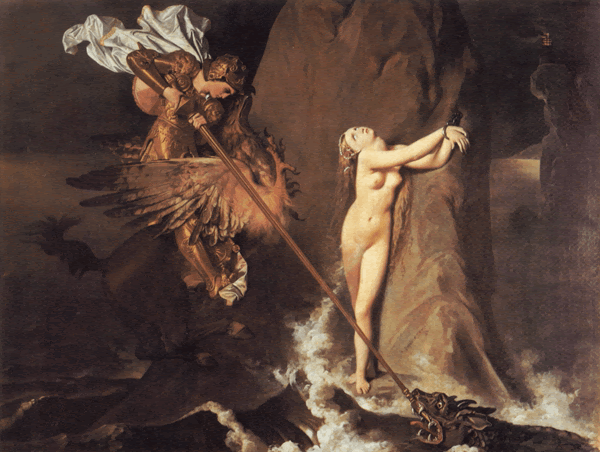
OLD MASTER WORK
CONTEMPORARY WORK
In 'Roger délivrant Angélique', Ingres creates a strict opposition between the depiction of Angélique, nude, attached, sexualised, and the depiction of Roger, empowered by the spear, killing the dragon. Their body language strengthens this opposition: Angélique's head is sagging back, desperate, whereas Roger's head is facing forward offensively. The battle between Roger and the dragon could be considered as a battle between Roger and his own desires he has to control in front of Angélique.
In 'The Nights I Don't Remember, the Nights I Can't Forget', Arcmanoro Niles, playing with the codes of the male gaze, reverses the classic representation of male and female bodies. The man is laying down, while the woman is depicted sitting above him and staring at us, as a sign of defiance. Here, the sexual desires are made explicit by the red drawings. Called ‘the seekers’ by the artist, they are magical beings that manifest our inner desires. They highlight the dominant role of the woman, as it is suggested by their body language. Thus, it highlights the previous couple’s innate desire for a sexual relationship where the woman dominates the man.
Our combination questions the classical representation of the male and female bodies and behaviours, in which women are turned into passive subjects of the male desires. Contemporary representations such as this Arcmanoro Niles' painting are an attempt to balance the representation of power between genders, as well as translate an updated version of the male gaze and heterosexuality.
REVERSING
THE
MALE
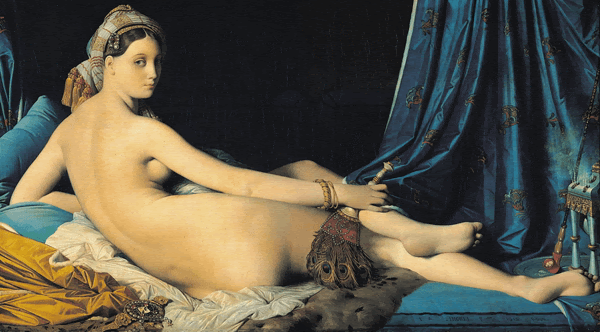
GAZE
‘La grande Odalisque’ by Ingres embodies classic orientalist fantasies of the period, with its expensive mise-en-scène of a concubine’s parlour. While she is depicted as a seductress, sensually looking at the viewers, her beauty is idealised. To exacerbate her erotic appeal and convey the impression of an endless back, Ingres lengthens the character's back by the equivalent of two lumbar and three vertebrae. Furthermore, and as indicated by the Odalisque’s pale skin, this depiction of an oriental concubine is not realistic as it follows classic European cannons of beauty. Indeed, Ingres’ main influences here are Renaissance paintings of the goddess Venus.
Contrasting this male gaze emphasis, ‘Morning studio’ offers an alternative look on the woman's body and a different approach to past influences. Nicole Eisenmann depicts an intimate moment between two women, whereas Ingres exacerbates the sexual potential of the concubine. The beauty of the topless woman is not idealised: her breasts are slightly saggy and tanning marks are visible.
Furthermore, Eisenman reinforces this desire for realism in the relationship portrayed, by using the aesthetic codes inherited from 17th century Deutsch genre painting, a type of work depicting scenes of everyday life.
While at first glance it may seem that Ingres’ portrait is more realistic, his Odalisque is a masterfully executed orientalist fabrication. On the other hand, and despite its aesthetic poetry, Eisenman’s portrait is a much more believable representation of two women. Unlike Ingres she draws artistic influences from the past but avoids reproducing elements of male gaze often present in classical European art.
SOCIAL
VIOLENCE
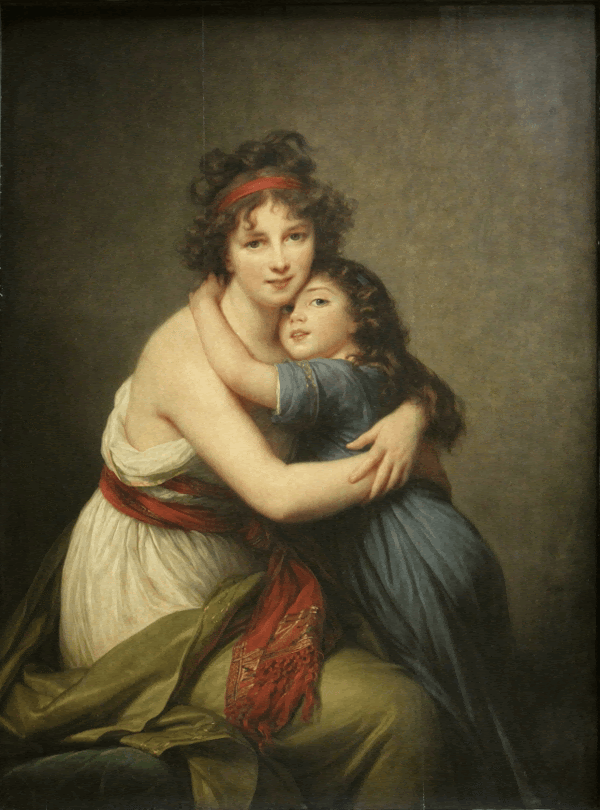
In ‘Autoportrait avec sa fille’ Elisabeth Vigée-Le Brun depicts an intimate moment with her daughter. It is a statement of her double social position: both as a mother and as a successful artist. Vigée-Le Brun’s assertion of her double social position in the Ancien Regime is a political act of social independence.
Tala Madani, in ‘At My Toilette #2’, also questions the role and place of women in society. This painting is part of her broader series ‘Shit moms’. She points out the lack of consideration of women, often limited to the unique role of mothers and sometimes accused of failing their children. The undifferentiated mother’s face allows the viewers to project themselves onto her. She directs the head of her daughter to the right, as looking towards the horizon and maybe towards the future, as if she was warning her of a similar motherly destiny. The title ‘At my toilette’ refers to the moment of self-care not as something entirely pertaining to her pleasure but equally as a construct of women identity in our societies.
Both paintings highlight the fact that the distribution of roles in society remains very gendered. Extreme and suffocating expectations are pushed upon mothers and daughters to have a special relationship. This combination also prompts us to notice and question the lack of female artists in museums’ collections. Elisabeth Vigée-Le Brun is the only woman artist present in the three rooms of the Louvres we have covered. This exemplifies a dominant discourse where women artists have been erased from international fine art museums and art history, leaving only male artists to be celebrated.
PHYSICAL
VIOLENCE

Eugène Delacroix’s ‘La mort de Sardanapale’ portrays the fall of the legendary Assyrian king Sardanapalus. In face of imminent defeat he orders his servants to destroy what belongs to him. Nothing that has served his pleasure and glory must survive him: from his domestic animals to his women. Sardanapalus is shown as part of the background, laying down, inactive and serene. He does not hold any more power. On the other hand, his victims are depicted in all their despair, fear and struggle, in face of an unjust death and at the mercy of a defeated man’s will.
In our first combination, Sheida Soleimani ‘Illuminated’ decomposes an orientalist vision of women, herself being an Iranian-American woman. Her collage of motifs deconstructs perceptions of Iranian women as well as depicting the violence inflicted upon them in Iranian society. The face of a multiplied female figure is anonymised by traditional Iranian motifs, reinforced by the multiple shots of Iranian carpets in the background. All that remains visible is a beaten body almost in the grasp of an octopus’ tentacle. Unlike Delacroix’s painting, violence upon the female figure is not aestheticised, but denounced.
MASCULINITY / MASCULINITIES
In our second combination, Michael Armitage’s ‘The Baboon’ exacerbates the artificial hubris that can animate male figures. In classic iconography, monkeys often serve as a parable to specific human traits. They portray sanguine and capricious temperaments, underlining a sense of heresy and emotional inconsistency. Armitage’s baboon appears collected and proud, in a similar position to Sardanapalus. This is due to his possession of a great number of phallic looking bananas. While this may seem derisory to the viewer, possessing those perishables establishes his position as the dominant one. It is as if nothing else but his personal pleasure matters to him.
Each of those propositions aims to discuss separate elements of Delacroix’s painting. ‘The Baboon’ intends to highlight the character of Sardanapalus and the destructive masculine hubris he represents, whereas ‘Illuminated’ opposes the orientalist depiction of women as idealised materialistic possessions without agencies.
OLD MASTER WORK
CONTEMPORARY WORK
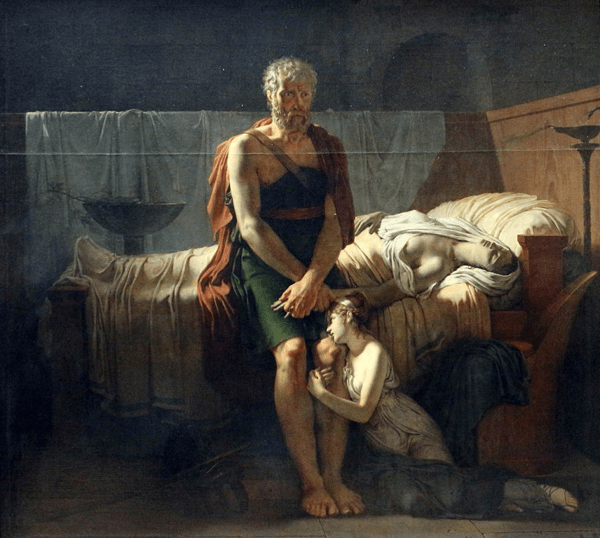
THE
WEIGHT
OF
GENDER
In 'Le Retour de Marcus Sextus' Pierre-Narcisse Guérin depicts a solemn Marcus Sextus faced with the death of his wife. Unlike his daughter who lays down at his feet and is submerged by her emotions, he is shown standing up, stoic, unable to express real sorrow.
This representation of Marcus Sextus illustrates the difficulty to represent men exteriorising their emotions. Even in a situation of crisis, the male expression of sadness has often been seen as a weakness and associated with feminine behaviours.
In 'Chamber of Reflection', Trey Abdella represents himself expressing a moment of fragility, crying hidden in some public toilets. Whereas Marcus Sextus is shown as tensed up and rigid, Abdella's persona is able to let go, away from the public eye. The latter accepts his distress when he is alone, and this feeling of seclusion is reinforced by the infinite reflections of the mirrors. Once again, the pretense of masculinity acts as a repressive social force, imposing emotional shackles on individuals, which still need to be destroyed in our societies.
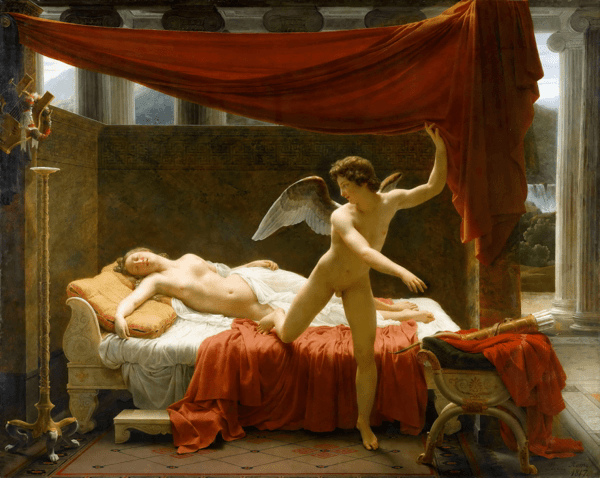
MALE
LOVE
In ‘L’Amour et Psyché’ Edouard Picot highlights classic elements of heterosexual love through the myth of Cupid and Psyché. Smooth skins, light features and prepubescent traits characterise the bodies of both lovers, emphasising a neoclassical aesthetic. Here, the bedroom is depicted as the privileged place for poetic sexual intercourses to happen.
In ‘Homo Homo Neanderthalensis (Spooning)’, Rasmus Myrup proposes an alternative reading of the same act and the same space. Unlike the heterosexual couple of Cupid and Psyché, Myrup presents the viewer with two homosexual neanderthals in the bed. While the neanderthals’ stone lances and tools could echo the quiver full of arrows and the harp of Eros, their boorish and muscular bodies do not fit the aesthetic canons of the previous couple. Yet, the neanderthals seem to convey a more realistic representation of couple dynamics.
This proposition aims to challenge representations of couple love and its preponderent heteronormativity. This contemporary vision also translates the evolution and diversification of masculine canons of beauty.
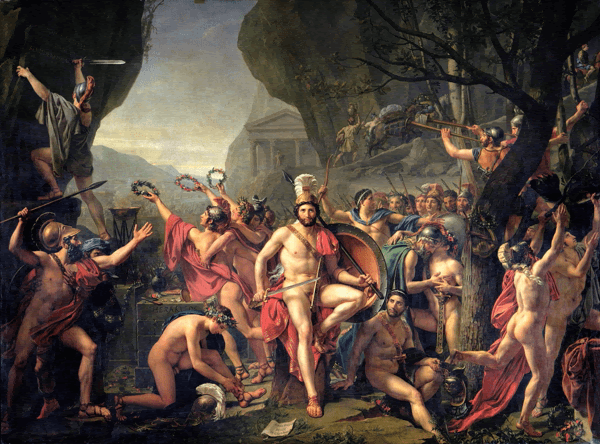
MALE
SENSUALITY
‘Léonidas aux Thermopyles’ depicts the Spartans celebrating their victory over the Persians. Jacques-Louis David exacerbates the muscled bodies, intertwining with each other, and highlights a sensual comradeship in a moment of collective euphoria. The label of the Louvre does not mention the obvious erotism present in this painting. Yet, the homoerotism of the scene makes sense on two levels: one linked to David's own sexuality, and the other to the sexual practices of the Greek army in those times.
In ‘Dance party’, Kyle Dunn portrays young men openly displaying the sensuality of their bodies. Their sportive outfits, juxtaposed with David’s work, could be seen as a nod to the Greek athletes and warriors. Both scenes are moments of collective male celebration. They also question a past and contemporary obsession for the trained and muscular body as a means of male identity and aesthetic expression.
Our combination highlights these aspects omitted by the Louvre’s label and questions how explicit are the representations of sexual desires on the man’s body as well as recounts the aesthetics of homoerotism in painting over centuries.

BREAKING
GENDER
ROLES
BEYOND DEFINITION
OLD MASTER WORK
CONTEMPORARY WORK
In this equestrian painting, Théodore Géricault glorifies the power and heroism of an officer of the French imperial guard. Sword in hand, the officer is wearing an ornate military costume. He is portrayed with total control over his mount, using as his saddle a feline fur, another predator like him.
In ‘More then party’, Maja Djordjevic humorously questions women's power. Here, the female character is screaming while riding a tiger. Depictions of women horseback riding are rare in art history and always gendered: they had to sit aside rather than astride, riding sidesaddle. In this painting, there are no weapons: the flower and the weights are a way to ironise about accessories attributed to each gender. Yet, the female character is imbued with a sense of strength and control. The pixelated body questions the representation of the female body in the digital age. The relation to animals is different. Whereas the feline fur was represented as a trophy by Géricault, the tiger is depicted as living and ferocious by Djordjevic. Riding it, the woman is empowered, benefiting from the aggressiveness of the feline, as an expression of her own energy.
This proposition is a counterpoint to the depiction of male power, over-represented on the walls of fine arts museums such as the Louvre.
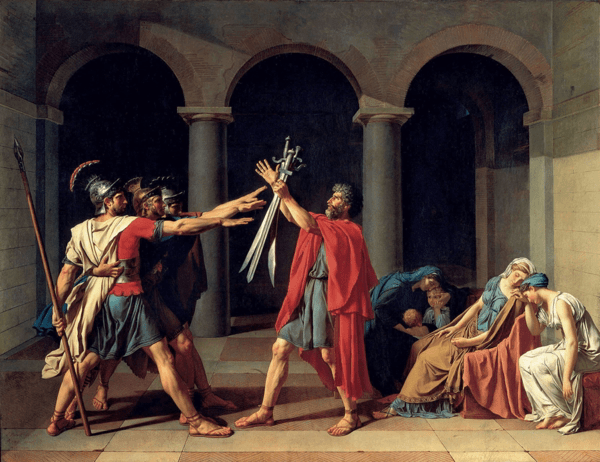
BREAKING
GENDER
ROLES
In his painting ‘Le serment des Horaces’ David offers one of the most famous depictions of this legendary tale, depicting the three Horatii brothers vowing to win the incoming battle to their father. They are shown in all their military might and glory, ready to defend the honour of their city and family. Offering their oaths to the swords only highlights the special character of war as the ultimate factor of resolution. On the other hand, their sisters hold no agency in the painting, and lay prostrated on a bench in face of their cruel destiny.
In Hannah Quinlan & Rosie Hastings’s ‘The Sleepers’, there is not such a clear division of gender identity and tropes in the depicted non-binary characters, invalidating any sense of dominance of one group over the other. All the characters are asleep, somewhat alluding to a general apathy in face of larger issues, yet, unlike the sisters, seem to face it with sensuality. Whereas David’s Horatii faced their fate through violence and patriarchal duties, our hedonist sleepers, much like our contemporaries, have no hold over history, but are able to live through it.
This proposal intends to question the classic representations of male and female figures, as primary or secondary actors, in an active or passive role, depending on their gender. Hannah Quinlan & Rosie Hastings offer to break this binary which opposes active male and helpless female figures, and represent a more varied and fluid expression of gender identity, emphasizing the idea that we are all equal in front of destiny.

‘POWER/body/GENDER’ does not aim to undermine the appreciation of old masters' works but to develop a more present-day understanding of it. The art historical discourses displayed in art institutions such as the Louvre, have to be scrutinised and challenged accordingly. The museum entity is not static and holds important cultural duties. The previously mentioned declaration of the International Council of Museums set a precedent regarding the reassessment of the past in light of the society we now live in. To this end, we want to encourage spectators to look at past artworks and art institutions in different ways. We believe that contrasting the past with contemporary artworks will lead to more fluid and critical interpretations, in sync with our times. The contemporary works selected in this project not only demonstrate the richness and variety present in current art productions, but also spotlights critical shortcomings in the interpretative and curatorial discourse of the Louvre.
Our e-exhibition is an invitation to re-imagine the curation of fine art museum’s collections, in order for them to finally become inclusive and critical spaces of knowledge.

We are grateful to the artists and their galleries for their support.
All the works are courtesy of the artists and their galleries, 2020:
Trey Abdella // Michael Armitage // Maja Djordjevic // Kyle Dunn // Nicole Eisenman // Hannah Quinlan & Rosie Hastings // Tala Madani // Rasmus Myrup // Arcmanoro Niles // Sheida Soleimani
T293 // White Cube // The Hole / Dio Horia // PPOW Gallery / Galerie Maria Bernheim // Anton Kern Gallery / Vielmetter Los Angeles / Hauser & Wirth // Arcadia Missa // Pilar Corrias / David Kordansky Gallery / 303 Gallery // Jack Barrett // Rachel Uffner Gallery // Edel Assanti
Special thanks to: Luke, Jeanne and Edouard

Click our names to keep in touch!










